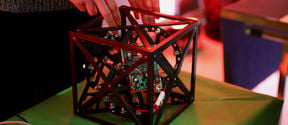Researchers printed energy producing photographs
A semi-transparent dye-sensitized solar cell with inkjet-printed photovoltaic portraits of the Aalto researchers (Ghufran Hashmi, Merve Özkan, Janne Halme) and a QR code that links to the original research paper.
Solar cells have been manufactured already for a long from inexpensive materials with different printing techniques. Especially organic solar cells and dye-sensitized solar cells are suitable for printing.
–We wanted to take the idea of printed solar cells even further, and see if their materials could be inkjet-printed as pictures and text like traditional printing inks, tells University Lecturer Janne Halme.
When light is absorbed in an ordinary ink, it generates heat. A photovoltaic ink, however, coverts part of that energy to electricity. The darker the colour, the more electricity is produced, The most efficient solar cell is therefore pitch-black.
The idea of a colourful, patterned solar cell is to combine also other properties that take advantage of light on the same surface, such as visual information and graphics.
The idea of a colourful, patterned solar cell is to combine also other properties that take advantage of light on the same surface, such as visual information and graphics.
– For example, installed on a sufficiently low-power electrical device, this kind of solar cell could be part of its visual design, and at the same time produce energy for its needs, ponders Halme.
With inkjet printing, the photovoltaic dye could be printed to a shape determined by a selected image file, and the darkness and transparency of the different parts of the image could be adjusted accurately.
– The inkjet-dyed solar cells were as efficient and durable as the corresponding solar cells prepared in a traditional way. They endured more than one thousand hours of continuous light and heat stress without any signs of performance degradation, says Postdoctoral Researcher Ghufran Hashmi.
The dye and electrolyte that turned out to be best were obtained from the research group in the Swiss École Polytechnique Fédérale de Lausanne, where Dr. Hashmi worked as a visiting researcher.
– The most challenging thing was to find suitable solvent for the dye and the right jetting parameters that gave precise and uniform print quality, tells Doctoral Candidate Merve Özkan.
The main research team behind the inkjet-printed dye solar cell. From left to right: Janne Halme, Ghufran Hashmi, Alpi Rimppi, Merve Özkan.
The research results opens up new possibilities for the development of decorative product- and building-integrated solar cells. The results were published in the most renowned journal in energy research, the Energy & Environmental Science.
The research was funded mainly by the Academy of Finland and the SELECT+ Erasmus Mundus Joint Doctoral Programme of the European Union.
Contact details:
University Lecturer Janne Halme
Aalto University (Finland)
Tel. +358 50 3441695
[email protected]
http://physics.aalto.fi/en/groups/newergy/
Research article : Syed Ghufran Hashmi, Merve Özkan, Janne Halme, Shaik Mohammed Zakeeruddin, Jouni Paltakari, Michael Grätzel, Peter D. Lund, Dye-sensitized solar cells with inkjet-printed dyes. Energy & Environmental Science, 2016, 9, 2453-2462. dx.doi.org/10.1039/C6EE00826G
- Published:
- Updated:
Read more news

Aalto ARTS alum Vidha Samya’s artwork featured at the Venice Biennale 2024
The Pavilion of Finland presents ‘The pleasures we choose’ at the 60th International Art Exhibition – La Biennale di Venezia until 24 November 2024.
IoT Forge donates EUR 1 million to the School of Engineering
The donation will be used for research and education on the Industrial Internet and digital twins.
Join us for the first Aalto Open Science Award Ceremony
All Aaltonians are welcome – no registration required!